You probably see them so often that you don’t even notice they are there. Fire hydrants are one of those things that aren’t interesting until you need them, but then they are of paramount importance. You sometimes hear them called fireplugs and it made us wonder what was a plug about it. Perhaps it was because that’s where you plug in your hose? Turns out, no. The real story is much stranger. Not to mention, did you know that there are even “dry” fire hydrants?
Apparently, in the 16th century, water mains were made of wood. When there was a fire, a team would dig the cobblestones out to expose the wooden mains and cut a hole to make an ad hoc well to fill buckets or to pump. Of course, after the fire, you had to repair the mains and that was done with a plug. The city would keep a record of plugs so that if a fire was nearby in the future, you could just “pull the plug” instead of making a new hole.
Eventually, the mains would have plugs put in every so often as a matter of course. With iron pipes, it wasn’t so simple, so that’s when we got the modern fire hydrant. In some parts of the world, you hear firecock instead of fire plug.
We don’t know if it is true, but apparently, fire brigades at one time were paid by the insurance companies and would often compete for the privilege of putting out a fire and, thus, getting paid. When a fire started, they’d send the meanest guy up ahead to protect the hydrant from competing fire companies. Since he was usually not terribly attractive this is supposed to be the origin of the phrase “plug ugly.”
Modern Times
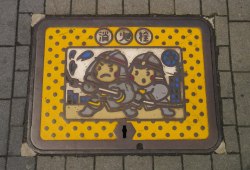
The cast iron hydrant first appeared in an 1801 patent by Frederick Graff of the Philidelphia Water Works. Ironically, there are no copies of the patent because of the patent office fire 1836.
In addition to weather-related improvements, the device also has had to deal with tampering. There is usually an unusual drive on the valve that takes a special wrench or, in some countries, a cover that you must remove before accessing the actual hydrant.
Old cast iron fire hydrants didn’t look much like we think of them looking today. And, the exact details do vary a great deal from country to country, as you can see below. Even the US doesn’t always have the iconic fireplug.
Finding the hydrants can be an issue at night or in snow, so there are various ways of marking them ranging from reflectors in the street (notice them next time you pass a hydrant) to flags or poles Underground hydrants like the Russian one above usually have a marker.
Under Pressure and Dry Hydrants
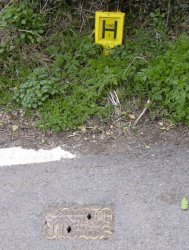
Typically, a fire hydrant has water under pressure from the supply line. In some countries, you can tell how much pressure by the color of the hydrant’s cap. The body color might mean something, too. Or there is further documentation. For example, in the UK a violet body indicates non-drinkable water, and external signs often indicate the size of the hydrant.
Even if a hydrant isn’t underground, snow can be a problem when trying to find a water supply in a hurry. Code For America developed an application that cities can use to allow citizens to adopt a fire hydrant, meaning they agree to clear it after snow storms.
However, there are also dry hydrants. These don’t have pressure and are usually just a pipe where one end is below the water level of a lake. A firetruck can connect to a dry hydrant and pump water into the truck’s tanks.
We hear the largest fire hydrant happens to be in South Carolina, but we were disappointed that it isn’t actually functional.
Banner image: “Fire Hydrant, November 15, 2016” by Maggie Osterberg

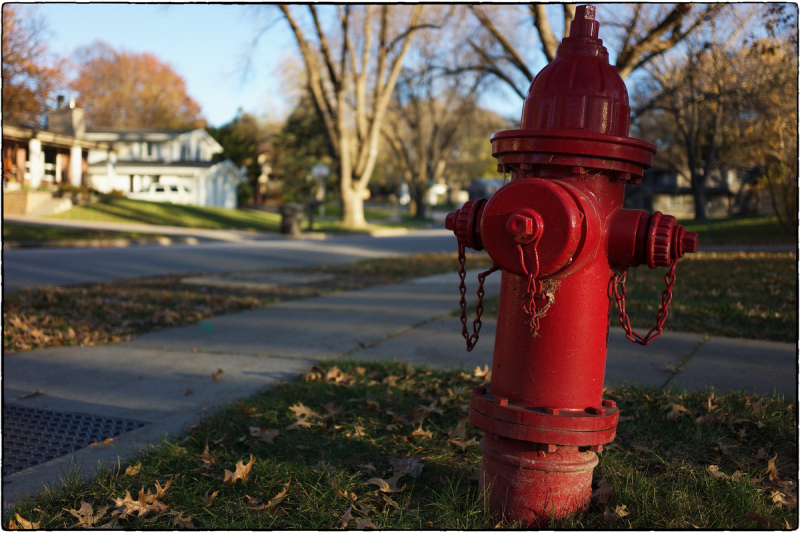
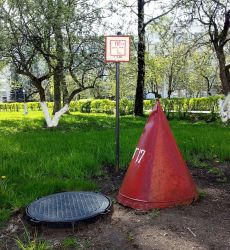
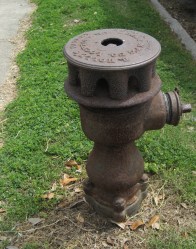
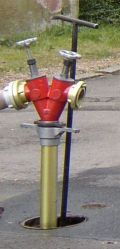















I used to work for Watts, and one of the more interesting memories of working there was watching fire hydrants (which is what we tend to call them around here in NH) being built. In those units the valve itself is located something like 6 feet underground (roughly 2 meters) and was operated by a long shaft which was connected to the top of the unit. As was mentioned in the article, this was done to prevent freezing, which is a real problem around here.
I used to work for a local water/fire company in CT and the added benefit of putting the valve so far down is that when a car hits the hydrant, the top piece can break away while the valve remains closed.
Unfortunately, it doesn’t always work that way. Happened to a dry barrel hydrant down the street from me and the company had to replace it down to the underground connection.
They also have built in drains so that should they get used in the winter, the water (above the frost line) in the hydrant drains out before it freezes again. Seems like a lesson someone learned the hard way.
I would use this in entry level fire figher training, except for the fact that the wet barrel hydrant drain is not illustrated. This is important to the operation of these hydrants.
And it’s important to shut the valve off fully, without breaking the coupling on the shaft. If left cracked open, it can wash away the base holding the hydrant up
The drain system is also the reason we learned to flush out a good amount of water from the hydrant, before you hook up the hose. You would want to wash out possible rust that gathered in there, as bigger rust flakes can clog up the spray nozzle, especially if they use smaller hoses and nozzles inside buildings that are not yet completely on fire.
It’s also the reason that you always open the hydrant up all the way if you need to flush one or pressurize a hose for standby use (industrial plant, we have our own local fire main). If you try to throttle it with the hydrant valve, you are potentially leaving that subgrade drain open, letting the high pressure water (~140 psig in our case) excavate a void around the pipe underground.
The length of the hydrant and it’s reach underground depends on your local frost line, which means that assuming you are in the US or Canada you are pretty far north. The MH Valve company makes most of them and we could tell how far north any shipment was going just from of its length.
https://www.annistonstar.com/free/across-the-country-you-can-find-hydrants-made-in-anniston-by-m-h-valve/article_d67034ba-eca4-11eb-827d-1766661a69b4.html
The ones I saw were at least 6 feet long, and they were being made for the New England market.
Being cast iron (in most of the USA) they are surprisingly heavy. I saw an abandoned hydrant in Baltimore with a short piece of pipe attached and thought it would look nice in my loft apartment. Needless to say, I could not lift it off the ground.
Keeps from happening what happens to road signs.
Too bad that hydrant in South Carolina has a fence around it.
The dogs there must really be disappointed.
In our neighborhood, it is not so much “adopting” a fire hydrant, but making sure there is no snow piled up around it and having a clear path to the street. After all, who’s to blame if the Fire Department is delayed hooking up their pumper while your house is burning?
Fire markers were placed on the outside of the building to show that you had insurance and the company that insured the property. You can still buy reproductions of the fire markers.
See https://en.wikipedia.org/wiki/Fire_insurance_mark
I think the ones in the Atlanta GA area are all located on maps available to emergency services because I noticed tags which look like gird marker locations attached to them with tack welds.
Ours are all geo located and the computer display in the engines will show them as well as flow rates and pressure rates (our district has 3,000 ft of elevation change.) The tops of our hydrants have to be color coded to show its pressure. At the low altitude end of a hydrant line, we have to gate the intake valve on the engine down low enough so that two firefighters can hold the attack end of the hose line and so that hose doesn’t burst if the line is shut down quickly.
Cool, I thought it was something like that, and keeping track of hose pressure and flow rate makes sense if there is that much difference. Next time I am walking about a dog I will have a closer look at the local ones without being creepy about it.
> so that hose doesn’t burst if the line is shut down quickly.
I have tried to convince family members not to drive over garden hoses when the spigot is on and the hose is full of water. I imagine if a heavy commercial type vehicle rolls over a high pressure hose while filled it could cause a host of problems.
Certainly in the Gangs of New York, they cover the part ablut rival gangs rushing to put out fires, and the pug ugly stuff.
Doesn’t mean it’s true though:
https://en.wikipedia.org/wiki/Plug_Uglies
https://www.etymonline.com/word/plug-ugly
Having a standard size for hoses in the US is great – except the city I live in decided many, many, many decades ago to go with a non-standard thread size. Companies love when Joplin orders fire equipment from them since the “special thread” increases the price.
I’m a firefighter an we also have non-standard thread that is coarser so as to be threaded on quicker, it’s called “Cincinnati Standard” they also are not self draining so anytime they are used they need to be pumped out. In winter we have to check them to make sure they are dry and not frozen from leaking or people using them and not pumping them out. Every hydrant in the city is checked at least once every two weeks or sooner with a sinker, a long strap with a weight on one end.
The US hydrant pictured is interesting for a number of reasons. It’s not just any hydrant; it’s a Holly. This guy kept watching cities burn to the ground in repeated fires, like the Great Chicago Fire. The fires were often started by the boilers found in the basement of every building. Birdsill Holly Jr had this idea of building just one really big boiler and piping steam to everyone around.
District heating is now in cities all over the world, and some places are even experimenting with district cooling.
So, not only did he design a classic piece of American street furniture, but he also pioneered the technology that made it so his fire hydrants would get less use.
This may sound weird but should I ever get to the States, this is on my perverse list of American things I would like to see: one of these quaint-looking old-timey red fire hydrants that appear in Hollywood movies.
Along with a letterbox with a little flag on it, a flagpole on every house, your famous upside-down light switches, and a wall socket with no earth pin and no switch.
Non-polarized wall sockets (outlets) – the ones with no earth – are common in houses built before 1963. My house was built in 1965 and it has three prong outlets with the earth pin. We call it the ground pin here in the USA. But none of our outlets are switched except for living room (family room) outlets that are wired for lamps, and this practice went away in the 1970’s. And why would outlets be switched when anything we would plug into one has it’s own power switch?
And I would have to see one of your country’s light switches to understand your upside-down light switch reference. Ours seem normal to me – up for on and down for off.
I’m not criticising them – just want to goggle and take a photo of things that are unusual to me.
I did not take your comment as being critical. I lived in Germany for 6 years and travelled to other European countries as a kid so I understand that different countries have different systems.
And it’s Google, not Goggle…
No, I meant what I typed https://idioms.thefreedictionary.com/goggle+at
I think I would goggle at a German power plug too, with its round pins :)
Funny, here in the US Google has become so engrained in our culture that Google has become a commonly used verb. It’s common place to hear some one say ‘I Googled that’ or ‘Just Google the question’. But Goggle, as in look at something, is far less common here.
There’s English and then there’s English. Years ago, I picked up a co-worker from the airport. She flew in from Ireland. She worked with me for two weeks on a database project. I found out at the end of those two week s that ‘pick up’ means something totally different in Ireland!
Yep same here, it’s definitely easier to say than ‘I duckduckgo’d that’ I suppose.
We thave idioms such as ‘I knocked up this amazing gizmo over the weekend’ which I believe has different connotations stateside. And you folks have ‘pickup trucks’ as well.
Here, ‘knocked up’ means she unintentionally got pregnant. And I do own a ‘pickup truck’.
They were switched because they didn’t always have a ceiling light. It’s much easier to flip a light switch on the wall when entering a dark room than to have to hunt your way past all the furniture and whatever else to turn on the lamp directly. Also, some early ceiling lights were just hung on from a hook on the ceiling and the wire ran to that switched outlet through a decorative chain. My house was built in 1965 and I believe at least the one back bedroom had this arrangement as there are hooks in the ceiling leading towards the corner. It does have a regular ceiling light now, but probably had one like this originally.
https://i.stack.imgur.com/lPoqJ.jpg
Having carried mail for 24 years…we called the boxes with flags “rural ailboxes” or ” curbside boxes,” as they are typically at the curb or edge of the road so that they can be serviced from a vehicle. Postal delivery vehicles have the steering wheel and controls on the right side, so that this can be done easily, or when parked, to step out for delivery, the carrier can exit safely on the curb side. One might not see these in all places, such as denser urban areas, as they might have walking routes there. There are whole YouTube series by Brits who show, what are oddities to them, how things are done in the US
My father was a fireman in a small town in DownEast Maine. The process at the time to prevent hydrants from freezing was to charge them with kerosine. The first volunteer fireman on scene had the job of opening the valve, spraying the kerosine off to the side until flushed and then attend to fighting the fire. He came in a little later and started as lead man on the hose. Unfortunately, that essential step had been omitted and he suffered a flashback from the fuel sprayed on the blaze. His arms and face were pretty badly burned. I remember him laying on the couch in the living room, arms covered with grease, holding his arms in the air because of the pain. This was probably early 1940’s. He recovered and became fire chief with a total of 50 years in the department. I’m sure the procedure for protecting the hydrants from freezing was changed quickly.
I just realized, no comment on when cars crash into a hydrant. Do they really break off, or does the car get more damage. And how often is there a torrent of water into the air?
Those with the shutoff valve below the frostline do not spout.
I was just watching the beginning of Superman II, anda car does it, and fills up with water. Maybe it doesn’t get cold in Metropolis.
If the crash happens at the right spot, the valve gets broken and water spouts. Happened to a hydrant down the street from me. The company had to shut off the valve next to the water main.
They have break away bolts and the valve turns on against the pressure so when one is struck the bolts break and the valve stem has a break away coupling so no water flows out. Hydrants get hit alot and I have only seen 1 time where water was shooting in the air like th movies.
Thanksto both ofyiu. Superman II came on, the one with Richard Pryor, and very esrly a car hits a hydrant, and fills up wih water. With this post in mind, I realized how common that was in movies, but I knew nothing more.
“Since he was usually not terribly attractive this is supposed to be the origin of the phrase “plug ugly.””
Whaaaat?!?
I was brought-up with “Pug Ugly” – as in “Pugilist Ugly” from having too many punches to the ol’ fizzog.
Interesting…
This statement is pure gold:
The cast iron hydrant first appeared in an 1801 patent by Frederick Graff of the Philidelphia Water Works. Ironically, there are no copies of the patent because of the patent office fire 1836.